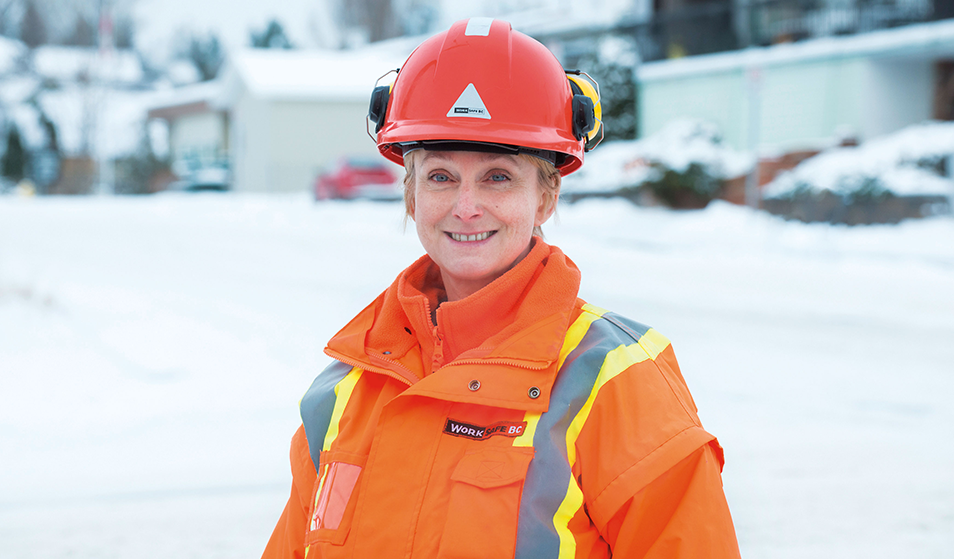Ask an officer: Snow removal plan reduces the risks of winter hazards
As winter grips B.C., occupational safety officer Teresa Chernowski answers questions about snow removal safety.
Teresa Chernowski
Occupational safety officer
Region: Prince George
Years on the job: 3
What do I need to do to prepare my crews for snow-clearing duties?
It’s all about planning. If you have to remove snow from your walk or roof, you should have a plan with written procedures in place. The first step is to conduct a risk assessment to identify hazards, then put controls in place to reduce the risks.
As part of your plan, you should identify the tools and equipment your crews will use and make sure they’re trained to safely operate them. You should also have an adequate rescue plan that takes into account how conditions may limit access to the site.
What does my plan need to consider for a roof-clearing operation?
Try to keep workers off the roof if possible. It may be possible to use another method, such as de-icing cables, extendable snow rakes, or an aerial lift.
If you do need to send workers up to your roof, determine what hidden hazards are on the roof, what kind of fall protection system you’re going to use, and how workers are going to access the roof. Whenever possible, put guardrails up and mark things like skylights, electrical connections, and tripping hazards. Install anchor points before it snows.
Have you considered the extra load created when workers and equipment are up there? You need to know what your roof’s maximum load limits are and how the snow should be removed to prevent an unbalanced load.
Snow places stress on your building so clear it in uniform sections and avoid making snow piles on the roof. I have seen a home under construction that collapsed due to workers creating an unbalanced snow load.
You can find snow load calculators on the web or consult an engineer. Your plan also needs to cover how you will safely dispose of the snow you’re removing.
Are there common injuries from clearing snow?
It’s a heavy job, especially if you get wet snow, so there is a potential for back strains and sprains. To prevent them, use proper lifting techniques. Keep loads light and lift with your legs, not your back. And definitely no twisting. It’s better to stand behind the shovel and push the snow forward. There are many styles and sizes of ergonomic shovels available to fit the user.
Heart attack is another risk because this can be such a strenuous activity. Many workers aren’t used to that level of exertion. Give yourself rest cycles so you’re not over-exerting yourself or getting too sweaty or too cold. Be sure to hydrate with water — most people are probably drinking coffee, which is a diuretic.
Being outside in cold weather raises the risk of hypothermia and frostbite, so dress appropriately; in northern climates, that means layers. Wear fabrics that wick moisture.
Good boots with non-slip treads are essential and safety glasses with UV protection might be needed on sunny days.
Is there anything I should know about using snowblowers?
In heavier snow, blowers have a tendency to plug up. If that happens, shut down the machine and use proper lockout procedures before clearing it out or changing the shear pins. Before refuelling, let it sit for a few minutes to cool. Otherwise you might have enough heat to ignite the fuel vapours.
Don’t forget that you and the rest of the crew should wear appropriate hearing and eye protection. And when using a snowblower in an enclosed area, such as a lower deck, be aware of the threat of carbon monoxide.
If you use a snowblower on a flat roof, always be parallel to the roofline and stay 15 feet away from the edge. Self-propelled models can pull you off a roof. Always watch your clearance distance from power lines and be aware of where you are blowing the snow.
What hazards can get overlooked when removing snow?
Watch for overhead hazards. For example, you can get a lot of snow that slides off the roof. If it’s wet, it compacts when it lands and it’s like cement. You could actually knock someone over and bury them. Icicles can be another overhead hazard. Cordon off areas and post warning signs on the ground to prevent workers and anyone else from entering a hazard area.
This information originally appeared in the January/February 2018 issue of WorkSafe Magazine. To read more or to subscribe, visit WorkSafe Magazine.

